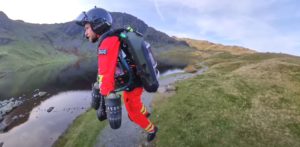Safety tech
Jet suit technology could massively cut rescue times
Jet suit technology is being trialled by paramedics in the Lake District, with the hope that it could cut rescue times in remote locations which are inaccessible by road.
 Great North Air Ambulance Service (GNAAS) believes it has carried out the world’s first trial of a jet suit for paramedics. Following a test flight, which was carried out in the Lake District, GNAAS says remote fell tops could be reached in around 90 seconds, as opposed to 30 minutes on foot.
Great North Air Ambulance Service (GNAAS) believes it has carried out the world’s first trial of a jet suit for paramedics. Following a test flight, which was carried out in the Lake District, GNAAS says remote fell tops could be reached in around 90 seconds, as opposed to 30 minutes on foot.
The test is a collaboration between Gravity Industries, which has developed and patented a 1050 brake horsepower jet suit, and came about following the culmination of a year of discussions between GNAAS and Gravity Industries.
Director of Operations at GNAAS, Andy Mawson, said that the technology has ‘huge potential’. He said: “We could see the need. What we didn’t know for sure is how this would work in practice. Well we’ve seen it now and it is, quite honestly, awesome.
“In a time in healthcare when we are exhausted with COVID and its effects, it’s important to still push the boundaries.
“Our aircraft will remain a vital part of the emergency response in this terrain, as will the fantastic mountain rescue teams. But this is about looking at supplementing those resources with something completely new.
“We think this technology could enable our team to reach some patients much quicker than ever before. In many cases this would ease the patient’s suffering. In some cases, it would save their lives.”
SHP’s safety technology expert John Kersey, author of SHP’s Robot Safety series, said: “Jet pack technology has a surprisingly long heritage being a popular experimental concept since the 1960s and so is well founded. This application gives a first responder the vital time advantage that can easily be the difference between life and death. It would also be very practical for inaccessible areas.
“The Gravity Industries jet suit has an advertised flight time of up to 10 minutes which gives a feasible range at its recorded speed of 30+ mph.”
Should this technology take off, coupled with applications like What3Words, it could really aid the safety and protection of remote and lone workers.
The Safety & Health Podcast recently featured an interview with Giles Rhys Jones, Chief Marketing Officer at What3Words, about how the geocoding system can be used to keep lone workers safe. Around 80% of the emergency services in the UK are already using What3Words to pinpoint an exact location at speed, in the event of an emergency.
In the video below, GPS co-ordinates are given to provide the location of the casualty.
Jet suit technology could massively cut rescue times
Jet suit technology is being trialled by paramedics in the Lake District, with the hope that it could cut rescue times in remote locations which are inaccessible by road.
Ankit Kumar
SHP - Health and Safety News, Legislation, PPE, CPD and Resources Related Topics
Drug and alcohol testing in a UK airport environment
Unleashing the power of emerging technologies in EHS
Passing the baton – Meet the 2024 IOSH President

 Great North Air Ambulance Service (GNAAS) believes it has carried out the world’s first trial of a jet suit for paramedics. Following a test flight, which was carried out in the Lake District, GNAAS says remote fell tops could be reached in around 90 seconds, as opposed to 30 minutes on foot.
Great North Air Ambulance Service (GNAAS) believes it has carried out the world’s first trial of a jet suit for paramedics. Following a test flight, which was carried out in the Lake District, GNAAS says remote fell tops could be reached in around 90 seconds, as opposed to 30 minutes on foot.